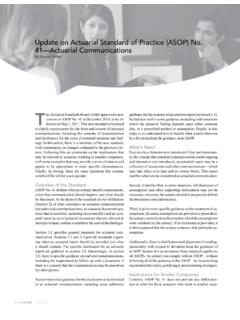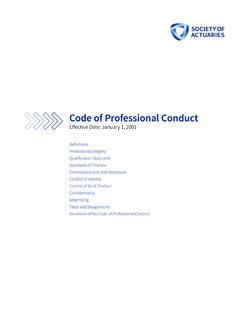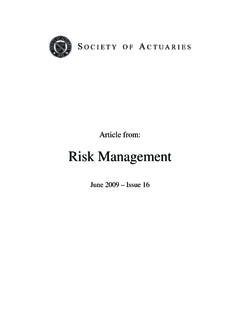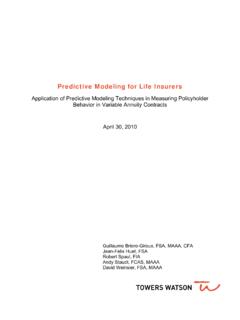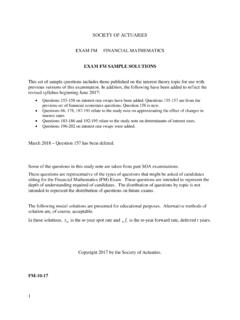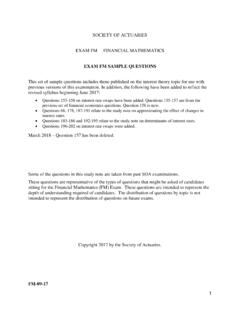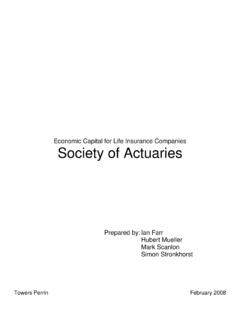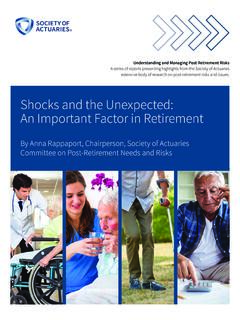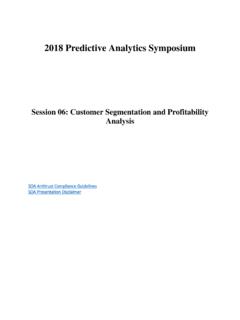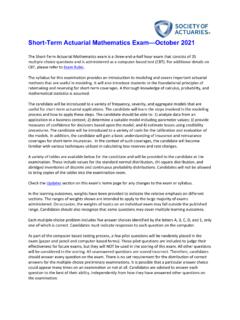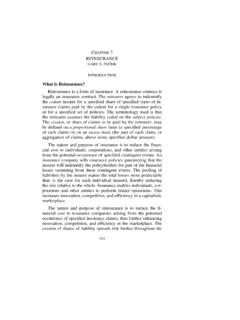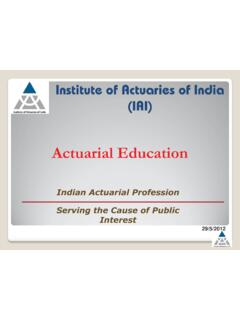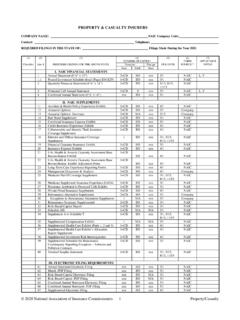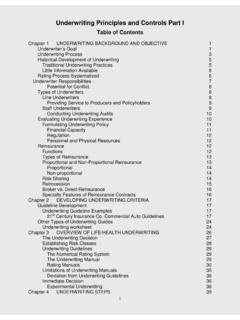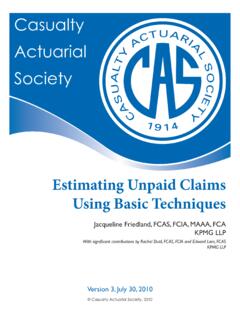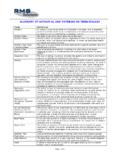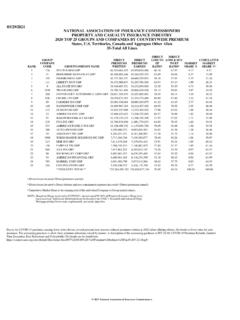Transcription of Fundamentals of Actuarial Practice (FAP) Descriptions and ...
1 Fundamentals of Actuarial Practice (FAP) Descriptions and Objectives Fundamentals of Actuarial Practice (FAP) 2 | P a g e Module 1: Introduction/Role of the Professional Actuary FAP Introduction: Course Overview Description: FAP encompasses real-world applications and uses examples to demonstrate Actuarial principles and practices . Practical techniques are presented to assist in your day-to-day work. You will also have opportunities to apply these principles and techniques in traditional and non-traditional Actuarial Practice areas. With the Fundamentals in your toolkit, you will be better prepared to apply your learning to new areas of Practice that may emerge during the course of your Actuarial career. FAP design and delivery supports your learning by: Introducing you to financial security systems, common Actuarial techniques, and practical experiences. Describing Actuarial practices , principles, approaches, methods, commonalities, problems, and solutions.
2 Explaining Actuarial practices across the traditional areas of Practice : o Life insurance o Property and casualty insurance o Health insurance o Retirement benefits Explaining Actuarial practices as applied directly on behalf of financial security system providers or as a consultant to those providers. Preparing you to apply Actuarial skills in nontraditional and emerging areas of Practice . Providing context for the specific mathematical and technical skills tested in the Preliminary Education examinations, some of which you may have already taken, others of which you might be studying for now: o Probability o Financial Mathematics o Investment and Financial Markets o Statistics for Risk Management o Long-Term Mathematics o Short-Term Actuarial Mathematics o Statistics for Risk Modeling o Predictive Analytics Helping you prepare for your professional role as an Associate of the Society of Actuaries (ASA).
3 Objectives: What are financial security systems? How do they operate? What issues do actuaries address? What is the actuary s role? How does the business environment affect the work of actuaries? How is Actuarial Practice expanding to fill newly developing roles? How do actuaries bring professionalism to their work? What types of problems do actuaries solve? What is risk in an Actuarial context? How do actuaries identify, assess and manage risk? How do actuaries apply the fundamental concepts of Actuarial science in their work? Fundamentals of Actuarial Practice (FAP) 3 | P a g e What solutions do actuaries bring to their bosses, management, boards of directors or clients? How can you articulate answers to each of these questions to a non-expert audience? Successful completion of the FAP course will enable you to answer these questions. Section 1: Module Overview Description: This section introduces the overall goals and purposes of Module 1: Role of the Professional Actuary.
4 You will be introduced to the profession, to traditional and nontraditional areas of Actuarial Practice , to the positions actuaries hold, and to their contributions as volunteers. Objectives: After you complete this section, you will be able to: Explain what actuaries are. Describe what actuaries do. Explain how actuaries Practice . Explain how actuaries work in a global context. Explain how the Control Cycle facilitates Actuarial work. Section 2: The Actuary Description: The purpose of Section 2: The Actuary is to provide a brief history of the profession, to consider the future of the Actuarial profession, to explore the role of today s actuary, to detail the actuary s skill sets and to review the profession s codes of conduct. Objectives: After you complete this section, you will be able to: Describe important historical events influencing the Actuarial profession. Describe today s Actuarial Practice .
5 Define actuary. Identify the actuary s knowledge, skills, and abilities. Describe what an actuary contributes as a professional. Describe Actuarial codes of conduct. Section 3: What Actuaries Do Description: The purpose of Section 3: What Actuaries Do is to explore the varied definitions of risk and identify how to define it in context, to consider how financial security systems function to manage and reduce risk, to introduce and investigate the areas of Practice in which actuaries work, to investigate how actuaries manage risk, and to look at the services actuaries provide. Fundamentals of Actuarial Practice (FAP) 4 | P a g e Objectives: After you complete this section, you will be able to: Define risk. Explain how financial security systems interact to combat financial insecurity. Describe the actuary s contributions within each area of Practice . Explain ways in which actuaries manage risk.
6 Identify services actuaries provide for financial security systems. Section 4: External Forces Description: In the previous sections, we reviewed how professionalism surrounds the Control Cycle. Professional codes of conduct and standards govern all Actuarial work, emphasizing the fact that an actuary is an expert employing a well-defined body of knowledge. An Actuarial designation provides you with instant credibility. To maintain your expert status in your Practice area, however, you must stay current. You must always be aware of emerging issues in the profession and in your clients lines of business. You must be aware of new advances in technology and how these advances may affect your work. You must assume the responsibility for continuing your education through formal offerings as well as informally through personal reading, for example. Your clients will assume that, as a professional, you are always up-to-date on the external factors that affect their business as well as the Actuarial profession.
7 External factors not only affect the work you will do as an actuary, they also affect how the Actuarial profession conducts its business. A practicing actuary does not work in a vacuum. External forces influence how the actuary works today and will work in the future. External forces can be thought of as forces that affect the problem or its solution. Further, changes in external forces may affect an existing solution and become apparent as an actuary monitors the results of a solution. Objectives: After you complete this section, you will be able to: List external forces that affect business Describe the elements of the Control Cycle. Explain how the Control Cycle facilitates Actuarial work. Apply the Control Cycle in the context of an Actuarial problem. Section 5: The Control Cycle Description: You ve been introduced to the Control Cycle as a framework for solving Actuarial problems. You ve learned that professionalism underlies the Control Cycle, while external forces, though generally outside of the actuary s sphere of influence, integrate with and affect the actuary s work.
8 The purpose of Section 5 is to complete your introduction to the Control Cycle by focusing on its Define the Problem, Design the Solution, and Monitor the Results stages. Section 5 also includes a Case Study Fundamentals of Actuarial Practice (FAP) 5 | P a g e that enables you to apply your learning and review a sample Actuarial problem in the context of the Control Cycle. Objectives: After you complete this section, you will be able to: Explain the purpose of the Control Cycle. Describe the elements of the Control Cycle. Explain how the Control Cycle facilitates Actuarial work. Apply the Control Cycle in the context of an Actuarial problem. Section 6: Communications Description: In today's business environment, professionals of all disciplines are turning to actuaries to identify, quantify, and manage risk-related issues. You can no longer assume your role as an actuary is to tabulate numbers.
9 The reasoning behind Actuarial calculations and the business decisions resulting from Actuarial analysis are valuable to today's organizations. This section will provide you with tips and guidelines on how to communicate effectively with professionals across all disciplines. It will also provide video examples demonstrating effective communication, as well as videos of expert actuaries who share their tips for effective communication. Objectives: After you complete this section, you will be able to: Prepare to communicate by answering six key communication questions. Describe elements of effective presentations. Describe elements of effective reports. Eliminating and limiting use of acronyms. Avoid common mistakes when communicating as an actuary. Apply the principles of Actuarial Standards of Practice 41 (US), Standards of Practice 1700 (Canada), and Section 8 Principle 6 (UK) Fundamentals of Actuarial Practice (FAP) 6 | P a g e Module 2: Core External Forces Section 1: Module Overview Description: As you learned in Module 1, the actuary works within the framework of a Control Cycle Define the Problem, Design the Solution and Monitor the Results and manages this process to arrive at an optimal solution.
10 Central to the actuary s work is the continuous examination of the core external forces that create new problems, constrain any potential solutions, change the problem being solved or affect existing solutions. External forces are any factors outside of the actuary s sphere of influence. The purpose of Module 2 is to provide you with an understanding of how core external forces affect Actuarial work. Identifying these forces and determining their relevance and interrelationships will help you manage Actuarial problems, projects and assignments. An understanding of external forces will help you assess risks in a variety of situations in an ever-changing environment. Objectives: After you complete this module, you will be able to: Define external forces. Describe and explain how the following categories of external forces apply within and across global areas of Actuarial Practice and fit into the Control Cycle framework.
